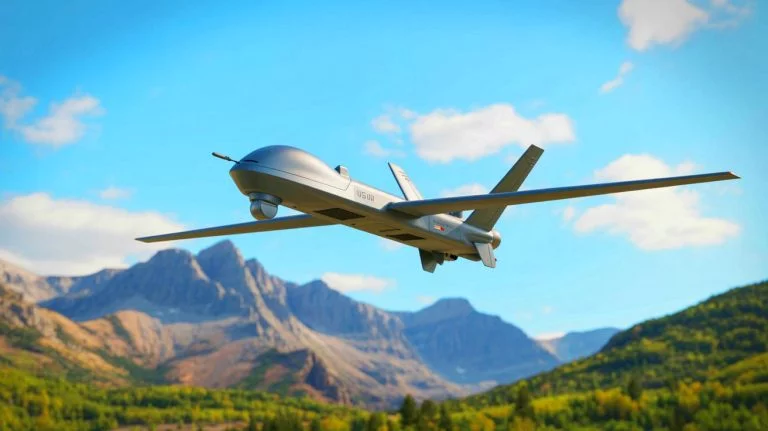| IN A NUTSHELL |
|
In a rapidly evolving world of technology and defense, China has once again showcased its prowess by unveiling a new tail-sitter drone during a disaster response exercise in Sichuan province. This innovative drone, capable of taking off and landing vertically, mirrors the design of the US military’s V-BAT drone. Its revelation during a rescue drill highlights its potential for real-time surveillance and autonomous flight. As geopolitical tensions rise, the development of such drones emphasizes the strategic importance of advanced technology in both military and civil operations. The implications of this new technology are profound, blending innovation with military strategy.
The Rise of Tail-Sitter Drones
The tail-sitter drone unveiled by China is a product of the Chengdu Aircraft Industry Group (CAIG), a subsidiary of the state-owned Aviation Industry Corporation of China (AVIC). With a wingspan of 8.5 feet and a length of 5.9 feet, this drone closely resembles the US military’s V-BAT drone. The V-BAT has been operational with the Navy, Marine Corps, and Army, as well as with allies like Ukraine and India. A single ducted fan engine powers the Chinese drone, allowing it to fly faster than a typical quadcopter while maintaining the ability to launch and land vertically.
Its compact size and vertical flight capability make it particularly useful in remote or difficult-to-reach areas where traditional launch systems are impractical. AVIC has designed this drone for quick response missions such as disaster relief, equipping it with various payloads, including cameras and sensors for reconnaissance. The modular design allows operators to switch out equipment depending on the mission’s needs, offering options like smoke or illumination effects. Supported by CAIG’s Wenyao control system, the drone utilizes artificial intelligence for flight planning and swarm coordination.
Autonomous Swarm Capabilities
One of the most groundbreaking features of this new drone is its autonomous swarm capability. The Wenyao control system enables the drone to assign tasks, plan routes, and manage multiple drones simultaneously without human intervention. This technological advancement makes drone swarming possible, a concept that has excited defense experts globally. According to China’s Science and Technology Daily, this system can autonomously manage all phases of drone operations, making it a valuable asset for both military and emergency scenarios.
AVIC has emphasized the affordability and ease of maintenance of this UAV, making it suitable for a wide range of operations. The company claims it can quickly reach disaster areas and perform comprehensive reconnaissance using its onboard sensors and camera equipment. This rapid response capability allows responders to quickly assess situations and strategize accordingly. China’s development of this UAV is part of its broader strategy to integrate advanced technology into military and civilian operations, demonstrating its commitment to becoming a leader in drone technology.
Applications and Global Implications
Although the drone has not been officially named or deployed, its presence in drills indicates it is nearing readiness for operational use. This development is part of a growing global interest in tail-sitter UAVs, which offer the combined benefits of helicopters and fixed-wing aircraft. As the technology behind these drones improves, countries like China and the United States are increasingly utilizing them for military and humanitarian missions. The ability to launch and land vertically without a runway, coupled with autonomous capabilities, makes these drones an attractive option for various applications.
The strategic use of such UAVs could significantly impact future military tactics and disaster response efforts. As nations invest in these technologies, the balance of power in international relations may shift. The deployment of advanced drones in military operations raises questions about airspace security, international law, and ethical considerations. The ability to conduct surveillance and intelligence gathering autonomously poses both opportunities and challenges for global security.
The Future of Drone Technology
As we look to the future, the development of drones like China’s new tail-sitter model underscores the rapidly changing landscape of defense technology. The integration of artificial intelligence, autonomous flight, and modular design in drone technology is shaping how nations approach security and emergency management. These technological advancements open new possibilities for reconnaissance, disaster relief, and military operations, offering increased efficiency and reduced risk to human life.
However, the proliferation of such technologies also raises important questions about their impact on international relations and ethical considerations. As countries continue to invest in and deploy advanced UAVs, the global community must consider how these technologies will shape the future of warfare and humanitarian efforts. How will the rise of autonomous drones influence the balance of power and ethical standards in international affairs?
Did you like it? 4.6/5 (23)







Is it a bird? Is it a plane? Nope, it’s a UFO… or a drone? 🤔
If it wasn’t for China stealing USA technology they would still be using the cart and donkey system. Maybe concentrate on your first home grown jet fighter engine instead of pilfering other countries. We give you way too much credit calling you a paper tiger when in reality you’d be lucky to be a wet paper tiger…
Wow, I can’t believe they “stole” our UFO. 😂 Classic!
This seems like a serious security issue. What actions is the Pentagon planning to take?
Is there any evidence that China actually copied the design, or is this just speculation?
Why does everything China develops have to be compared to US tech?
Thanks for the article. It’s fascinating to see how drone tech is evolving worldwide.
I’m not buying it. Sounds like a Hollywood plot to me. 😒